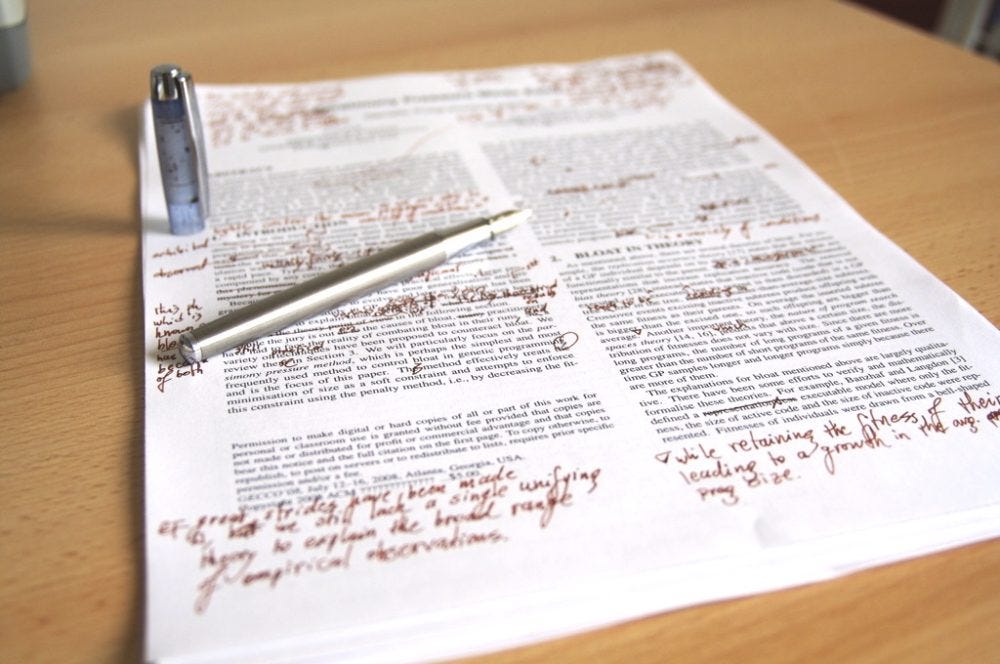Part 1 Of The Editing Tutorial Series. Cutting Down That Word Count
You spend years cultivating your manuscript only to be told it needs to be shorter. A lot shorter. Here's what I learned about cutting down the word count as part 1 of an Editing Tutorial Series.
Granted, this editorial series isn’t likely to attract any new subscribers. However, it does focus on some of the key aspects of bringing a manuscript to publication. It may only be now, a year in, I realise that the book proposals I’ve sent were optimistic at best. The subject matter of the New Yorkshire Wave may have piqued some interest, perhaps the Cast of Characters too. But there’s one field that may have been holding me back this entire time, the expected word count. A deal-breaker, if you will.
Too. Many. Words.
In purely logistical terms, more words means more pages and more printing costs. I initially looked at Lizzy Goodman’s Meet Me In The Bathroom and thought that its word count of 160,000 was a target to aim for. Consequently, I looked at packing my manuscript full of detail and ensured that it included EVERYTHING. Every physical release. Every reference to file-sharing. Every anecdote. I even packed it full of my own narration and split up quotes that could have been left alone.
This is my first manuscript, so I wanted to do the best job possible. Cover all bases, leave no stone unturned. What I ended with was what I believe to be a complete account, but one that went way over the top. Rather like the rambles of someone in the pub trying to explain a complicated, convoluted story, the manuscript appeared unwieldy and lacked focus. Everything was present and correct, but covered in distracting subplots and minor details.
Lesson 1. Stick to the central focus of the story and if it doesn’t quite fit, leave it out.

What To Edit Out
In what looks like some tangible interest in the manuscript from a publisher, I was told in no uncertain terms that the manuscript needs to be cut down. At first, this sounded quite drastic. Almost like losing a limb. I’d need to lose almost half of the manuscript. Initially, the fear set in. Then I thought about it in practical terms and wondered how much of the story I’d actually lose, yet I managed to do it without missing out too much at all.
Once I honed in on the crux of my story, I became quite cut-throat in the editing process. I’d ask myself, ‘Does it fit?’, ‘Is it relevant?’ and ‘Will anyone notice if it isn’t included?’. A lot of the time, if I was even slightly unsure, it’d be deleted. That’s partly a testament to how many words I’d have to get rid of. If I cannot be convinced that an excerpt needs to stay, then a potential reader won’t be interested.
Lesson 2. Ask yourself if the excerpt deserves inclusion. Every. Single. One.
The Editing Process
To cut down a manuscript, it certainly helps when you know which bits of flab can go. The bits that you thought were potentially irrelevant, or just not that interesting, are easy edits. I took out whole, meaty chunks that could have been the focus of another book entirely.
After taking out those chunks, I checked the word count again. Though it was streamlined, I had only done half of what was required. I needed to go in deeper.
What was left was still focused but still a bit flabby. When I read it back, I realised that in many parts my narration added nothing at all. It either repeated the central meaning of a quote or simplified it. Those were gone.
There were so many instances of this that it amounted to over 10,000 words. Plus, I got a manuscript that looked and sounded more like an oral history, with juicier quotes and long passages where several individuals were telling the story.
Multiple reviews of the same album or single that sounded similar did not need to be repeated. Far too often, music journalists would, essentially, say the same thing and I only needed one example to demonstrate a certain point or perceived bias. Typically, I’d choose a publication that expressed its views more succinctly and omit the other one. That’s another few thousand words gone.
Lesson 3. Avoid repetition, even from different sources.
Over the course of a couple of weeks, I’ve trimmed down a 180,000-word manuscript. Initially into 107,000 words and now 75,000. Bearing in mind, a redrafting process tends to remove words rather than add them, that should bring it down to a tight total.



